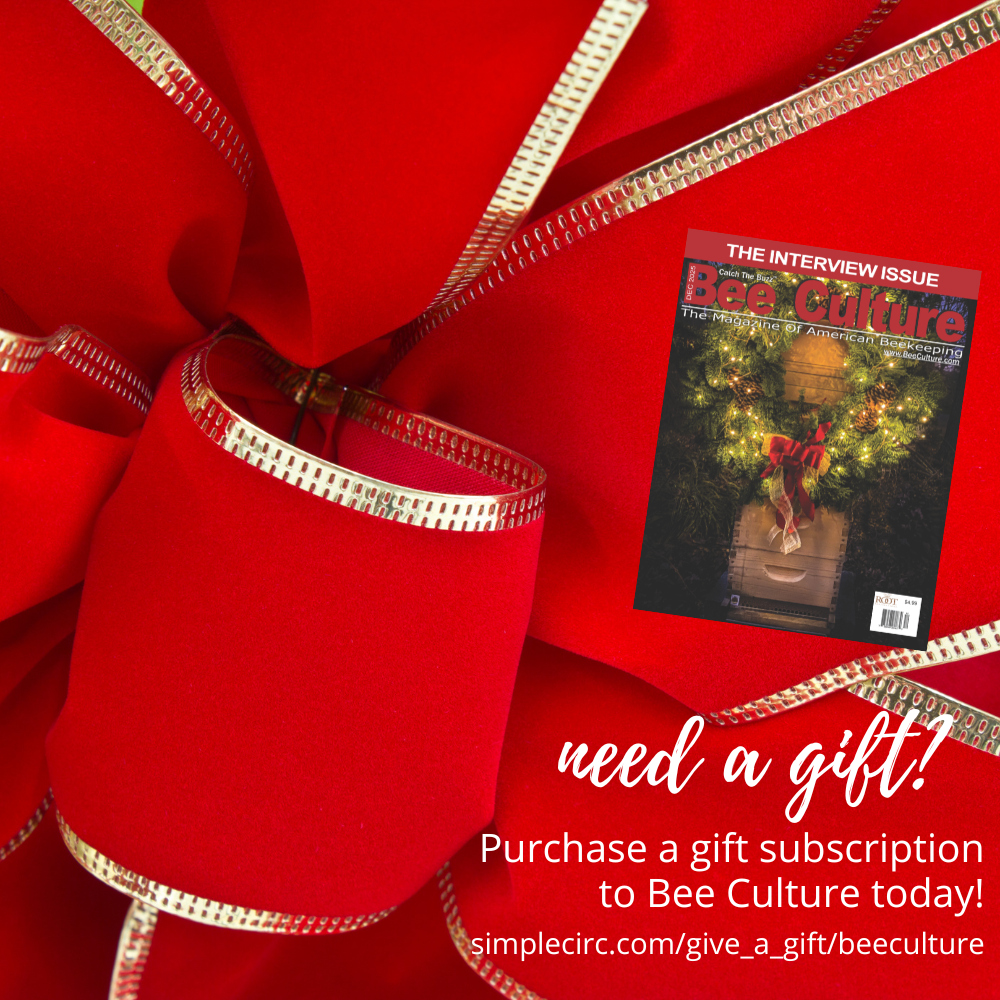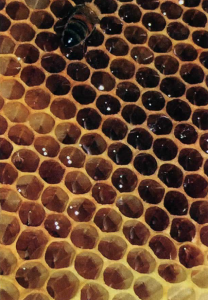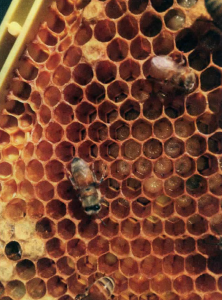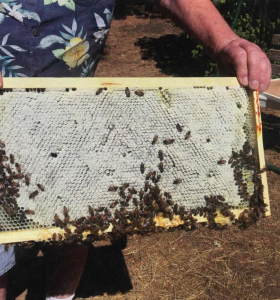By: Charlie Vanden Heuvel
This article originally appeared in the Autumn 2018 issue of BEEKeeping Your First Three Years
The three legs of survival for the honey bee consist of a viable Queen, sufficient nurse population to sustain the brood production, and nutrition. In the struggle to maintain healthy hives it seems the third leg is least considered. As beekeepers, pests and diseases along with brood patterns seem to dominate literature. Much like our own health, paying a bit of attention to nutrition appears prudent.
Multiple factors impact the stress of the honey bee colony. Anecdotal evidence derived from beekeepers strongly suggests that applying timely and consistent feeding regimens (both protein and carbohydrates) suffered diminished losses (Sagili, 2012).
Honey bees require carbohydrates (derived from sugars in nectar or honey), amino acids (protein in pollen), lipids (fatty acids, sterols), vitamins, minerals (salts), and water. Each of these elements must be present in the right ratio for a colony to thrive.
Pollen is gathered from plants and flowers, it is the male contribution to the next generation of plants. The pollen is mixed with nectar to form ‘bee bread’, a protein-rich food which is fed to the young brood propelling their growth from egg to larvae to pupae and ultimately becoming a healthy adult bee.
Nosema ceranae, a gut parasite, has been treated with Fumagillin, which is no longer being manufactured. Evidence strongly suggests diverse pollen intake from quality sources drastically reduces the prevalence of this affliction (Eischen and Graham, 2008). Parallels are easy to visualize between human health and the honey bee when it comes to nutritional balance. Commercial bees thrust into the mono pollen culture in the almond pollination endeavor were found suffering. Bee nutrition consists of two primary sources: pollen and nectar. Pollen is the honey bees’ source of protein, lipids, sterols, vitamins, minerals and certain carbohydrates (Todd and Betherick, 1942). Nurse bees provision pollen, having been processed along with the addition of glandular secretions in feedings to the brood. Bee bread or worker jelly undergoes conversion through paired food glands, hypopharyngeal glands (HPG) located in the frontal area of the worker bee’s head. This protein-rich jelly is fed to the Queen, Drone and Worker larvae.
Nectar becomes the primary source of carbohydrates. Sugar concentration, varying from 5% to 75%, typically ranges in the 25% to 40% range. The foraging bee sucks up the flower’s nectar through its proboscis storing it in her honey crop (stomach). Should the forager require energy, she is able to allow some of the crop nectar into her system via the preventriculus, a structure posteriorly situated on the crop allowing it to flow into the digestive midgut. This structure also acts as a one-way value preventing contamination of the nectar in the crop (Huang, 2010).
Nectar consists of complex array of chemicals along with sugars. Amino acids, lipids, proteins, organic acids, vitamins and inorganic minerals are also evident (Baker and Baker, 1975).
Honey, for the bee, is the source for energy-intensive foraging and colony thermoregulation. The adult bee requires continuous carbohydrate intake. Younger adult bees sustain themselves through abdominal lipids. These lipids are diminished as the bee progresses into its latter life gathering nectar and pollen.
Resistance to pathogens, are enhanced through enzyme-based immune responses of encapsulation, phenyloxidase, and lysozyme activity (Siva-Jothy et al., 2005). Simply put, poor nutrition allows the ever-present disease and pest onslaught to prevail leading to colony demise.
Malnutrition in honey bee populations lead to immune system impairment and increased pesticide susceptibility. Focusing hive management toward prophylactic treatments in pest and diseases in lieu of an eye toward to balanced nutrition diminishes survivability and weakens lines of successive generations.
Immunocompetence within a colony produces stress, giving way to biotic stress factors allowing vectored viral pathogens as well as pests to take hold (Gennaro Di Prisco, 2016). Thus, a correlation exists between nutrition and the ability of the honey bee to ward off singular but more often multiple stress agents. Reduction of foraging habitat coupled with inattention to the importance of nutritional needs has led to higher incidences of loss.
Identified stress factors on honey bee health include a variety of issues. Although pesticides are one of the identified sources, singular focusing on this issue muddies other prevalent ones. Beekeeping, especially in the smaller backyard variety, has escalated significantly. Although the new beekeeper ventures with a big heart, often the lack of knowledge of honey bee biology and behavior results in hive losses.
How often is the cry emitted from a bee loss due to Small Hive Beetle, Wax Moth or the seasonal Winter loss? All while ignoring nutritional needs of the bee. Attention to pre-Winter management leads to lessor losses, and of course, strong colonies emerging in the Spring.
Ignoring this vital leg of nutrition in the honey beehive’s health produces poor management. The introduction of the Varroa Destructor Mite in the late 1980s exacerbated this oft-neglected aspect. Viruses, evident prior to the onslaught of the mite, took a quantum leap forward in their presence as the Varroa proved an exceptional vector. Consider the relationship of the mosquito to viral proliferation as a parallel to the Varroa’s role in the honey bee’s health.
The reduced foraging habitat must be considered commensurate with the hives micro-climate in consideration of bee nutrition. Supporting the protein sustenance with pollen substitute is a positive management technique. Substitute alone fails to provide additional requirements such as sterols. Peppering the patty with fresh pollen brings greater nutritional balance.
Encouragement amongst new beekeepers to seek out education through books, local bee clubs, and viable mentoring should be developed. Sporadic attention to the health of the hive only leads to tears of sadness. Numerous sources exist delineating hive management. Unfortunately, the novitiate is unaware of these sources or ignores their importance.
Let us not focus our entire research army toward new acaricides. An enhanced appreciation of the nutritional needs, physiology and sources of honey bee nutrition is strongly indicated.
References:
Baker, H.G. & Baker, I. 1975. Studies of nectar constitution and pollinator-plant coevolution. In: Coevolution of animals and plants, (eds) Gilbert, L.E. & Raven, P.H., pp. 100-140. University of Texas Press, Austin. Barrows, E
Honey Bee Nutrition. (n.d.). Retrieved April 14, 2018, from http://articles.extension.org/pages/28844/honey-bee-nutrition
F.A. Eischen, R.H. Graham. Feeding overwintering honey bee colonies infected with Nosema ceranae Am. Bee J., 148 (2008), p. 555
Gennaro Di Prisco a,l, Desiderata Annosciab, 1, Marina Margiottaa, Rosalba Ferraraa, Paola Varricchioa, Virginia Zannib, Emilio Caprioa, Francesco Nazzib, 2, and Francesco Pennacchioa. A mutualistic symbiosis between a parasitic mite and a pathogenic virus undermines honey bee immunity and health, retrieved from https://www.researchgate.net/publication/297662735 A mutualistic symbiosis between a parasitic mite and a pathogenic virus undermines honey bee immunity and Health
Information Sheet 4. (n.d.). Retrieved April 14, 2018, from https://cals.arizona.edu/pubs/insects/ahb/inf4.html
Ramesh Sagili. Comprehensive evaluation of role of nutrition in honey bee colony losses (n.d.). Retrieved from https://www. ney.com/ftles/general/Sagili NHB Final Report Dec2012.pdf&p=DevEx.LB. l.5530.l













